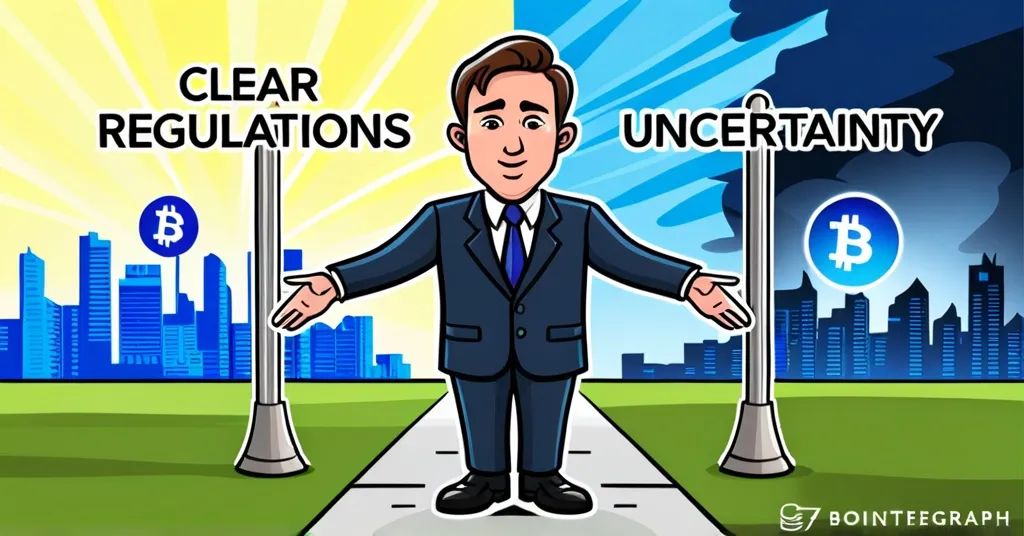Bank of America’s CEO: Crypto Adoption Depends on Clear Regulations

Bank of America CEO Signals Crypto Adoption Hinges on Regulatory Clarity
Can banks and cryptocurrencies coexist? Bank of America’s CEO thinks so, but there’s a catch.
- Bank of America’s crypto adoption hinges on regulatory clarity.
- Non-anonymous, verified transactions emphasized.
- Blockchain investments by Bank of America continue.
At the World Economic Forum in Davos, Switzerland, Bank of America CEO Brian Moynihan threw down the gauntlet on the future of cryptocurrencies in the banking sector. He expressed a cautious optimism, envisioning a world where banks fully embrace digital currencies for transactions, contingent on one critical factor: the establishment of clear regulatory frameworks. Moynihan’s vision isn’t about toppling the U.S. dollar; it’s more like inviting digital currencies to the dollar’s birthday party.
“If the rules come in and make it a real thing that you can actually do business with, you will find the banking system will come in hard on the transactional side of it,” Moynihan declared. This statement underscores the pivotal role that regulatory guidelines will play in enabling the banking sector to move forward with crypto.
Non-anonymous, verified transactions, which Moynihan emphasized, refer to digital currency exchanges that require identity verification to prevent fraud and comply with regulations. This requirement aligns with Bank of America’s broader investment in blockchain technology, where the institution holds hundreds of patents. Investing in blockchain technology is like buying a plot of land in a new city; it’s about owning a piece of the future.
However, the road to crypto adoption is strewn with regulatory potholes. Initiatives like “Operation Choke Point 2.0,” a regulatory effort to limit banking services for certain industries, including crypto, and the SEC’s SAB 121 have slowed down banks’ crypto initiatives. These regulatory uncertainties have created significant hurdles, though there are signs of progress. The U.S. Senate passed a resolution to lift the ban on banks offering crypto custody services, though efforts to rescind SAB 121 have hit a wall.
Looking ahead, there’s speculation about how the Trump administration might approach crypto regulation. While specifics remain as clear as mud, there’s a hope that guidelines around digital assets might be clarified, potentially smoothing the path for banks like Bank of America to further engage with cryptocurrencies.
Despite the challenges, Bank of America’s stance reflects a broader trend among financial institutions to explore the potential of blockchain and digital assets. Moynihan’s vision for crypto as another payment method rather than a threat to traditional currencies offers a balanced view of the future of finance. Yet, the road ahead is not without its critics. Some argue that the push for ‘non-anonymous’ transactions undermines the privacy and freedom that many in the crypto community cherish. Others question whether regulatory clarity will ever truly align with the decentralized ethos of cryptocurrencies.
As advocates of decentralization and effective accelerationism, we must weigh the benefits of broader adoption against the potential loss of privacy and freedom. While Bitcoin maximalists might see any form of regulation as a threat, it’s crucial to recognize that altcoins and other blockchain technologies also play vital roles in this evolving landscape. They fill niches that Bitcoin itself might not serve well, offering diverse solutions to the financial revolution.
Key Takeaways and Questions
- What conditions did Brian Moynihan specify for banks to adopt cryptocurrencies?
Moynihan stated that banks would adopt cryptocurrencies for transactions if clear regulatory rules were implemented and if transactions could be non-anonymous and verified.
- How has Bank of America engaged with blockchain technology?
Bank of America has invested in blockchain technology, holding hundreds of patents in the area, and processes most transactions digitally.
- What is the stance of Bank of America regarding cryptocurrencies as a threat to the U.S. dollar?
Bank of America does not view cryptocurrencies as a threat to the U.S. dollar but sees them as another payment method.
- What regulatory challenges have U.S. banks faced in adopting cryptocurrencies?
U.S. banks have faced challenges due to regulatory uncertainties, including “Operation Choke Point 2.0” and the SEC’s SAB 121, which have slowed down their crypto initiatives.
- What efforts have been made to address these regulatory barriers?
The U.S. Senate passed a resolution to lift the ban on banks offering crypto custody services, but efforts to rescind the SEC’s SAB 121 rule have been unsuccessful.
- What are the expectations regarding crypto regulation under the Trump administration?
There is speculation that the Trump administration might clarify guidelines around digital assets, but specifics are unclear since crypto was not included in initial executive orders.



